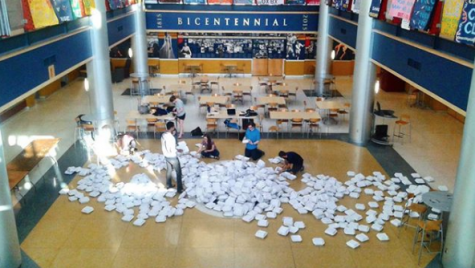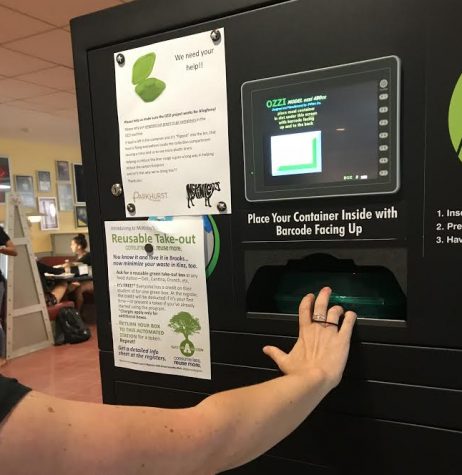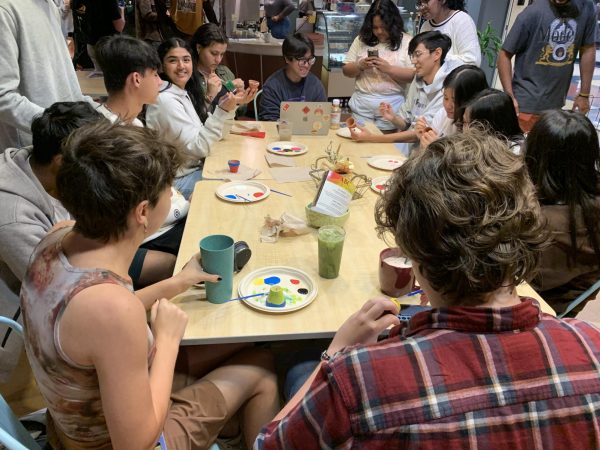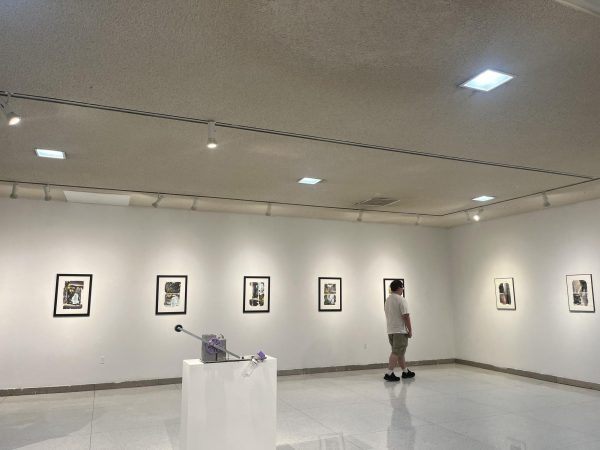Getting greener: Reusable to-go boxes come to McKinley’s
After six years of offering reusable to-go boxes in Brooks Dining Hall, Allegheny College has brought the to-go box program to McKinley’s Food Court, the result of a collaboration between Parkhurst Dining Services, the Office of Sustainability and Allegheny Student Government.
“We create enough waste in McKinley’s to fill the Wise Center pool 12 times,” said Kelly Boulton, ’02, sustainability coordinator.
This visualization is based on McKinley’s compostable paper waste produced in one year, waste production that could be mitigated with the newly established program in McKinley’s, according to Boulton.
When reusable to-go boxes were first brought to Brooks in 2012, Boulton wanted to initiate a campus-wide program that would include both Brooks and McKinley’s, she said. However, because of how the two facilities are organized, the details for a program in McKinley’s were more complicated to work out.
“The problem with McKinley’s was, because you pay at the end, there was no easy point at the beginning of the transaction to swap a dirty box for a clean box, and you can’t do that at the food stations because it’s a health code issue,” Boulton said.
Director of Board Operations Stephanie Lang said the limited dishwashing capacity in McKinley’s, relative to the large capacity in Brooks, as well as limited storage space in McKinley’s and the possibility of adding labor costs for employees to collect used boxes were also challenges that needed to be addressed before launching the program in McKinley’s.

Students for Environmental Action demonstrates the level of McKinley’s waste production from compostable to-go boxes on April 15, 2017, in the Henderson Campus Center lobby.
Boulton said an OZZI machine was purchased with funds provided by ASG to avoid major changes to McKinley’s operations.
The OZZI machine purchase was approved by ASG, according to both Boulton and Akeem Adesiji, ’20, former ASG director of sustainability and environmental affairs.

Sustainability Coordinator Kelly Boulton, ’02, places a reusable to-go box in the McKinley’s Food Court OZZI machine. When boxes are placed in the slot, the barcode on the box is scanned, and a token is released in return.
The ASG Class of 2020 Student Action Fund was approved by ASG to provide $15,000 for the $21,782.50 total cost of the OZZI machine, barcode stickers, tokens, scanner and other machine supplies in the spring, according to the ASG Class of 2020 SAF Proposal. The remaining balance was covered by the ASG Surplus Fund, the proposal states.
Located inside McKinley’s near the registers, OZZI is designed specifically for the collection of reusable to-go containers. At McKinley’s, used containers deposited in the OZZI machine are sanitized and returned to food stations by Parkhurst employees.
The boxes used in Brooks are the same type used in McKinley’s, but each McKinley’s reusable box has a barcode sticker on the bottom, which is scanned by the OZZI machine upon return.
When students are finished with a reusable box, they can exchange a used box for a clean one at Brooks or a used box for a token at either Brooks or OZZI in McKinley’s. The token can then be used at either location to receive a clean box, and boxes taken from one location can be returned to the other.
To date, OZZI machines have diverted approximately five million disposable containers from landfills, according to the company website.
The OZZI company produces its own reusable plastic products, including boxes, cups and silverware, but the college opted to use the same type of box already in use at Brooks because of its level of performance, according to Lang.
The green boxes are a regional product of Whirley-DrinkWorks in Warren, Pennsylvania. The boxes are made with a BPA-free plastic, Boulton said, and were initially selected because of Whirley’s low prices and the durability of their product.
The initial order of Brooks reusable boxes was funded by the Office of Sustainability and ASG with replacement and maintenance costs covered by Parkhurst, Lang said.
Prior to the official start of the to-go box program at Brooks, Boulton said she worked closely with students to test the strength of the boxes.
“I worked with a student at that time, and I gave her a couple boxes and said ‘Look, your job this week is to just try to destroy them — throw them down stairwells, I want you to open and close them a million times, see if these are going to last,’” she said.
Boulton also recalled having students take the test boxes to the Brooks dishwashing room to run them through several times in a row. Boulton and Lang both said they have been pleased with the longevity of the Whirley’s boxes.
“I maybe throw out 10 a year, and with the amount that we do purchase, that’s a very, very small percentage,” Lang said.
The Brooks transition to reusable boxes began as a voluntary program, with white compostable boxes available for free when it launched. Now, participation in the program is incentivized, and students must pay for a white compostable box at Brooks if they do not wish to use a green box.
Using a white compostable box with a compostable cup at Brooks costs 50 cents for the box and 25 cents for the cup, according to Yvonne Longstreth, Brooks greeter. Purchasing only the compostable cup costs $1, to fill one’s own reusable cup is 75 cents and to replace a lost or damaged green reusable box is $3, Longstreth said.
The McKinley’s program is currently voluntary, with white compostable boxes still available at no cost, but Lang said she hopes to eventually pull the compostable boxes back from counters and see an increase in green box use after working out any issues this year.
While the college is committed to making use of its composting facilities, and composting can theoretically be great, the white compostable boxes are difficult to keep up with in practice, according to Adesiji.
“We don’t have the capacity in our composting facility to run that much material … and we have too much dry material and not enough wet material to keep the ratio right, so most of those boxes are just being thrown away,” Adesiji said.
The bulkiness of the to-go boxes combined with low amounts of wet food material to help break down the boxes does not allow for effective composting, so boxes get discarded when the college’s composting facility cannot take in any more dry material, Boulton explained.
“Students keep coming to me and saying — ‘Can we start composting in the residence halls?’ — which we would love to do, but we can’t do because we have so many compostable containers coming out of McKinley’s,” Boulton said.
Future opportunities to compost excess college materials at a different, local compost facility are possibilities, according to Boulton, but whether materials are composted at Allegheny or elsewhere is not the point. Boulton said the real goal is reducing total waste.
“Less waste going to a landfill is better from a waste production standpoint, but also, that minimizes the amount of greenhouse gas emissions that are coming out of that waste breaking down in the landfill,” she said.
Reducing total waste may reduce the college’s carbon footprint and contribute to its goal of carbon neutrality by 2020, according to Boulton’s calculations.
Boulton has worked out that the effect of the Brooks reusable to-go box program can be described by the planting of 100 trees and the carbon emissions they would offset. In the same way, McKinley’s could also make an impact, with the possibility of over 400 trees metaphorically offsetting emissions.
“It’s so important because, number one, it’s eliminating our carbon footprint,” Lang said. “The college has a passion for that, and Parkhurst is able to adapt to what the college wants.”
Lang said Parkhurst is happy to be a “champion” for what the college believes in and help its students develop habits they can take with them when they leave Allegheny. She said the reusable to-go boxes are an exciting project and hopes to see the McKinley’s program be as successful as the Brooks program.
“It’s just been easy now, our team has really developed a system for it down here, and I rarely see the white boxes,” Lang said. “Where before, we were going through probably 300 every two days, so it really does eliminate a lot of our paper waste and our paper cost.”
Student involvement has been essential in working to offer reusable boxes campus-wide, according to Boulton, who has worked with several sustainability student workers, ASG directors of sustainability and environmental affairs and Students for Environmental Action members.
Adesiji recalled one of his first experiences working toward offering more reusable boxes — a Spring 2017 demonstration hosted by SEA in the lobby of the Henderson Campus Center where club members stacked white compostable to-go boxes and shared waste statistics with the hashtag, #ACdoawaywithtakeaway on social media.
Boulton said she hopes to continue collaborating with students through ASG and its current Director of Sustainability and Environmental Affairs, Cathlin Lord, ’20.
Sections regarding student interest in reusable to-go boxes were included in the 2011 ASG-administered Student Life Survey when the Brooks program was being discussed, and Boulton said she looks forward to receiving student feedback again. Although no formal survey is currently planned, she said she welcomes questions and concerns.
With the semester now underway, the OZZI machine is up-and-running in McKinley’s, and Boulton said it will eventually be able to notify Parkhurst via text message or email when the cart inside the machine is getting full.
As with most changes, Lang said, the transition may take some getting used to but will be beneficial in the long-run.
“If we create habits now of being more green, being more conscious of our carbon footprint, that will continue throughout the rest of your adult lives, and maybe you’ll pass it on to your kids,” Lang said. “Is it going to be as easy once you’re out of college? No, but it’s definitely something we want to instill in all of you.”





